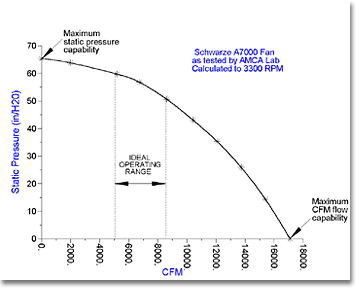Choosing Sweeping Equipment

Choosing Sweeping Equipment |
 |
Sweeper Fan CFM Ratings:Are You Getting What You Think You Are?by Leon Drake
A common question asked in sweeper purchase decisions is "What is the fan's cubic feet per minute of airflow (CFM) for this unit?" As this is often a fill-in-the-blank item on a specifications listing, there is no way to let the buyer know if this is a good measure of sweeper performance, or how to compare it to the numbers provided by the other sweeper manufacturers. The opinion widely held is that more is better - and even more is better yet. So, in an effort to comply with customer requests, some vendors will simply answer the question with as large a number as they can get engineers to go along with without fear for their lives and careers. As Paul Harvey says, here's the rest of the story. The fact is that big numbers on paper do not indicate what the sweeper will be capable of on the job. Currently, it's popular to rate sweeper fans at their maximum flow rates off of the sweeper. Yes, it's done that way because when you take out the system in which the fan operates, the number will be higher! The number you're reading is the theoretical maximum flow that the fan 'could' do in a world with no friction, no hopper, no hoses and no sweeping head! This is not exactly a 'real world' number because, as we all know, putting the fan in a system of hoses, ducts and chambers takes a significant amount of pressure to operate. This leads to a wide variation in the actual usable number, which would need to take into account how well each particular sweeper has been engineered in terms of airflow. It also leads to yet another error. The fan's quoted pressure is, again, what it would be able to do off the sweeper. This is at a 'no-flow' condition where the inlet is plugged, so it could be said that the stated CFM actually represents the maximum suction available if the inlet were to become completely blocked. So, as you can see, these numbers are actually at opposite ends of the fan's capabilities. One end of the spectrum for fan operation in a sweeper is at no-flow (intake blocked 100%), and the other is at free-flow (unblocked operating capacity). Unfortunately, it is typically assumed when reading the manufacturers' stated CFM numbers that the pressure and flow rates are in normal operation at that CFM. This is not true. The given numbers for CFM and static pressure are at opposite ends of the fan curve and are not related to each other. Confused? Probably. That, precisely, is the point: most sweeper manufacturers want to keep you confused. This prevents you from questioning the numbers lest you appear ignorant - or reveal their ignorance. Actually, you can't normally be expected to know this information unless you happen to be a fan engineer. You see, every fan has a characteristic 'fan curve.' You may have seen these graphs before. If so, chances are they probably made little sense apart from being composed of a lot of wiggly lines. However, these curves are vital to those who design fans and fan systems. 
An air sweeper is actually a fan system because it has ducts, hoses, chambers and separators. Each of these imparts some resistance to the flow of air. Add them together and you have a system, and each particular sweeper's fan system has added more or less resistance to the fan's capabilities. Each particular sweeper system's resistance to flow will cause the fan to operate somewhere on that fan curve. Certainly it will not be at the maximum flow on any sweeper, because there is always some resistance. We would also assume that some air is flowing, in any make or model of sweeper under normal operating conditions, so the reading is also not going to be at the maximum pressure (blocked). The actual flow rate of the sweeper should fall between 30-50% of the maximum rating. This is where the fan is most efficient. Not surprisingly, the exact point depends on how well the fan is designed. Sizing a fan for a sweeper is the art of finding a design that uses the least horsepower at the flow and system resistance the sweeper needs. An oversized fan will be inefficient but look good in the bid specifications and on brochures. In the real world this wastes fuel and makes more noise. On the other end of the spectrum, an undersized fan will not allow the full potential of the sweeper's design to be utilized. The only way to accurately determine from the sweeper specifications how it will compare in the real world is to know what flow rate, pressure and horsepower the sweeper operates at in normal conditions. Sounds simple, right? Unfortunately, it isn't. That's because different engine speeds and leaf bleeder door positions will yield very different results. It depends on what you sweep and how you sweep it. Until the sweeper manufacturers choose to get together to develop a standardized test that represents all of the range of operation, the only really good test is in the sweeping. Take it out and run it. Head-to-head tests are the best indication of performance. Leon Drake has been a fan specialist for over 20 years. He was an engineer with the fan design team of Schwarze Industries, Inc., and a principal designer of that company's proprietary technology, the WhisperWheelsm fan system. This article is reprinted from American Sweeper magazine, Volume 8 Number 1, 2000. |
© 2005 - 2021World Sweeper
|
Return to: |